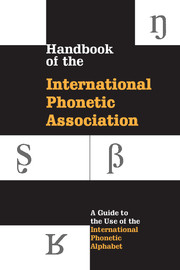 Handbook of the International Phonetic Association
Handbook of the International Phonetic Association Published online by Cambridge University Press: 06 November 2023
From its earliest days (see appendix 4) the Association has tried to make explicit the principles which guide its work. The statement of these principles has been amended and updated from time to time; the current formulation (below) was approved at the 1989 Convention of the Association.
1 The International Phonetic Association has a standard alphabet which is usually referred to by the initials IPA, or, in a number of non-English-speaking countries, API. It is designed primarily to meet practical linguistic needs, such as putting on record the phonetic or phonological structure of languages, providing learners of foreign languages with phonetic transcriptions to assist them in acquiring the pronunciation, and working out roman orthographies for languages written in other systems or for languages previously unwritten. A large number of symbols and diacritics is also provided for representing fine distinctions of sound quality, making the IPA well suited for use in all disciplines in which the representation of speech sounds is required.
2 The IPA is intended to be a set of symbols for representing all the possible sounds of the world’s languages. The representation of these sounds uses a set of phonetic categories which describe how each sound is made. These categories define a number of natural classes of sounds that operate in phonological rules and historical sound changes. The symbols of the IPA are shorthand ways of indicating certain intersections of these categories. Thus [p] is a shorthand way of designating the intersection of the categories voiceless, bilabial, and plosive; [m] is the intersection of the categories voiced, bilabial, and nasal; and so on. The sounds that are represented by the symbols are primarily those that serve to distinguish one word from another in a language.
3 In the construction of the IPA attention has been paid not only to the appropriateness of each symbol from a phonetic point of view, but also to the suitability of symbols from the typographical point of view. The non-roman symbols of the IPA have, as far as possible, been made to harmonize with the roman letters. For instance, the Greek letters included in the IPA are roman adaptations; as the ordinary shape of the Greek letter β does not harmonize with roman type, in the IPA it has been given the form β.
To save this book to your Kindle, first ensure [email protected] is added to your Approved Personal Document E-mail List under your Personal Document Settings on the Manage Your Content and Devices page of your Amazon account. Then enter the ‘name’ part of your Kindle email address below. Find out more about saving to your Kindle.
Note you can select to save to either the @free.kindle.com or @kindle.com variations. ‘@free.kindle.com’ emails are free but can only be saved to your device when it is connected to wi-fi. ‘@kindle.com’ emails can be delivered even when you are not connected to wi-fi, but note that service fees apply.
Find out more about the Kindle Personal Document Service.
To save content items to your account, please confirm that you agree to abide by our usage policies. If this is the first time you use this feature, you will be asked to authorise Cambridge Core to connect with your account. Find out more about saving content to Dropbox.
To save content items to your account, please confirm that you agree to abide by our usage policies. If this is the first time you use this feature, you will be asked to authorise Cambridge Core to connect with your account. Find out more about saving content to Google Drive.